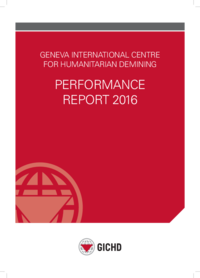In 2016, the GICHD worked towards the implementation of its current Strategy (2015-2018) under the three Strategic Objectives and corresponding Strategy Outcomes (SOs). Over the course of 2016, the GICHD supported countries in their efforts to fulfil obligations under the Anti-Personnel Mine Ban Convention (APMBC) and Convention on Cluster Munitions (CCM) or reach completion targets; to transition to sustainable national entities with the capacity to address residual contamination; and to integrate fully mine action into the broader human security sector.
The GICHD measured progress towards the SOs by focusing on results stemming from Spearhead Projects - one single project for each SO - with an exception for SO 3.3 where multiple projects were taken into account.
The results of the second year of the strategy implementation indicate that progress towards seven of the nine SOs is on track. In the case of SO 3.2, two Spearhead Projects were selected in the second half of the year only and thus will be reported on next year. In the case of SO 2.2, finalisation of adaptation of the Information Management (IM) Capacity Development Framework to a residual contamination context is now scheduled for 2017 and initial baselines assessments (conducted every 2 years) for 2018. Therefore, contribution towards SO 2.2 is off track. This is due to prolonged work in understanding the implications of the residual contamination context on information requirements so that appropriate indicators for IM Capacity Development project are selected (Annex 1- Progress Review; Results Matrix for SO 2.2). This work is closely linked with the conclusions of the case study carried out under SO 2.3.
Category: Ammunition Management

